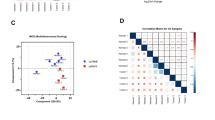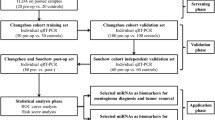Abstract
Objective
The aim of the present study was to systematically review the role of circulating miRNAs as potential prognostic biomarkers in head and neck cancer patients.
Materials and methods
PubMed, EMBASE, Scopus, Web of Science, and gray literature from January 1990 up to and including September 2019 were searched. The study selection was performed by two independent reviewers according to eligibility criteria.
Results
A total of 13 studies that met the eligibility criteria were included. Significant number of studies were executed majorly in China and predominant number of them were case-control in nature. A total of 22 different miRNAs were found to be concomitant with very poor prognosis in cancers of the head and neck region. Of these, eighteen miRNAs (miR-375, miR-1234, miR-103, miR-638, miR-200b-3p, miR-191-5p, miR-24-3p, miR-572, miR-483-5p, miR-20a, miR-22, miR-29a, miR-29b, mir-let-7c, miR-17, miR-374b-5p, miR-425-5p, and miR-196a) were upregulated and four miRNAs (miR-9, miR-29c, miR-223, and miR-187∗) were downregulated. The hazard ratio (HR) ranged from twofold to fivefold.
Conclusion
Based on the results, circulating miRNA may assist in the prediction of prognosis of head and neck cancer. Further multi-center randomized controlled clinical trials with large sample size are required to validate the results of the present review.
Clinical relevance
Decoding the circulating miRNA profile could aid in accurate prognostication of head and neck cancer.

Similar content being viewed by others
Abbreviations
- mRNA:
-
messenger ribonucleic acid
- MeSH:
-
Medical Subject Headings
- HR:
-
hazard ratio
- DFS:
-
disease-free survival
- OS:
-
overall survival
- NOS:
-
Newcastle-Ottawa scale
- κ :
-
Cohen’s kappa coefficient
- OSCC:
-
oral squamous cell carcinoma
References
Hwang H-W, Mendell JT (2006) MicroRNAs in cell proliferation, cell death, and tumorigenesis. Br J Cancer 94:776–780. https://doi.org/10.1038/sj.bjc.6603023
Di Leva G, Croce CM (2013) miRNA profiling of cancer. Curr Opin Genet Dev 23:3–11. https://doi.org/10.1016/j.gde.2013.01.004
Zhang B, Pan X, Cobb GP, Anderson TA (2007) MicroRNAs as oncogenes and tumor suppressors. Dev Biol 302:1–12. https://doi.org/10.1016/j.ydbio.2006.08.028
Wu C, Wang C, Guan X, Liu Y, Li D, Zhou X, Zhang Y, Chen X, Wang J, Zen K, Zhang CY, Zhang C (2014) Diagnostic and prognostic implications of a serum miRNA panel in oesophageal squamous cell carcinoma. PLoS One 9:e92292. https://doi.org/10.1371/journal.pone.0092292
Mitchell PS, Parkin RK, Kroh EM, Fritz BR, Wyman SK, Pogosova-Agadjanyan EL, Peterson A, Noteboom J, O'Briant KC, Allen A, Lin DW, Urban N, Drescher CW, Knudsen BS, Stirewalt DL, Gentleman R, Vessella RL, Nelson PS, Martin DB, Tewari M (2008) Circulating microRNAs as stable blood-based markers for cancer detection. Proc Natl Acad Sci 105:10513–10518. https://doi.org/10.1073/pnas.0804549105
Lubov J, Maschietto M, Ibrahim I et al (2017) Meta-analysis of microRNAs expression in head and neck cancer: uncovering association with outcome and mechanisms. Oncotarget 8. https://doi.org/10.18632/oncotarget.19224
Jamali Z, Asl Aminabadi N, Attaran R, Pournagiazar F, Ghertasi Oskouei S, Ahmadpour F (2015) MicroRNAs as prognostic molecular signatures in human head and neck squamous cell carcinoma: a systematic review and meta-analysis. Oral Oncol 51:321–331. https://doi.org/10.1016/j.oraloncology.2015.01.008
Moher D, Liberati A, Tetzlaff J, Altman DG (2009) Preferred reporting items for systematic reviews and meta-analyses: the PRISMA statement. BMJ 339:b2535–b2535. https://doi.org/10.1136/bmj.b2535
Wells GA, Shea B, O’Connell D, Peterson J, Welch V, Losos M Tugwell P The Newcastle–Ottawa Scale (NOS) for assessing the quality of non-randomised studies in meta-analyses http://www.ohri.ca/programs/clinical_epidemiology/oxford.asp. Accessed 22 Mar 2020
Romeo P, Colombo C, Granata R, Calareso G, Gualeni AV, Dugo M, de Cecco L, Rizzetti MG, Zanframundo A, Aiello A, Carcangiu ML, Gloghini A, Ferrero S, Licitra L, Greco A, Fugazzola L, Locati LD, Borrello MG (2018) Circulating miR-375 as a novel prognostic marker for metastatic medullary thyroid cancer patients. Endocr Relat Cancer 25:217–231. https://doi.org/10.1530/ERC-17-0389
Sun G, Cao Y, Wang P, Song H, Bie T, Li M, Huai D (2018) miR-200b-3p in plasma is a potential diagnostic biomarker in oral squamous cell carcinoma. Biomarkers 23:137–141. https://doi.org/10.1080/1354750X.2017.1289241
Lu J, Liu Q-H, Wang F, Tan JJ, Deng YQ, Peng XH, Liu X, Zhang B, Xu X, Li XP (2018) Exosomal miR-9 inhibits angiogenesis by targeting MDK and regulating PDK/AKT pathway in nasopharyngeal carcinoma. J Exp Clin Cancer Res 37:147. https://doi.org/10.1186/s13046-018-0814-3
Liu C-J, Lin J-S, Cheng H-W, Hsu YH, Cheng CY, Lin SC (2017) Plasma miR-187* is a potential biomarker for oral carcinoma. Clin Oral Investig 21:1131–1138. https://doi.org/10.1007/s00784-016-1887-z
Ye S-B, Zhang H, Cai T-T, Liu YN, Ni JJ, He J, Peng JY, Chen QY, Mo HY, Jun-Cui, Zhang XS, Zeng YX, Li J (2016) Exosomal miR-24-3p impedes T-cell function by targeting FGF11 and serves as a potential prognostic biomarker for nasopharyngeal carcinoma. J Pathol 240:329–340. https://doi.org/10.1002/path.4781
Sun L, Liu L, Fu H et al (2016) Association of decreased expression of serum miR-9 with poor prognosis of oral squamous cell carcinoma patients. Med Sci Monit 22:289–294. https://doi.org/10.12659/MSM.895683
Xu H, Yang Y, Zhao H, Yang X, Luo Y, Ren Y, Liu W, Li N (2016) Serum miR-483-5p: a novel diagnostic and prognostic biomarker for patients with oral squamous cell carcinoma. Tumor Biol 37:447–453. https://doi.org/10.1007/s13277-015-3514-z
Qiu F, Sun R, Deng N et al (2015) miR-29a/b enhances cell migration and invasion in nasopharyngeal carcinoma progression by regulating SPARC and COL3A1 gene expression. PLoS One 10:e0120969. https://doi.org/10.1371/journal.pone.0120969
Summerer I, Unger K, Braselmann H, Schuettrumpf L, Maihoefer C, Baumeister P, Kirchner T, Niyazi M, Sage E, Specht HM, Multhoff G, Moertl S, Belka C, Zitzelsberger H (2015) Circulating microRNAs as prognostic therapy biomarkers in head and neck cancer patients. Br J Cancer 113:76–82. https://doi.org/10.1038/bjc.2015.111
Liu N, Cui R-X, Sun Y, Guo R, Mao YP, Tang LL, Jiang W, Liu X, Cheng YK, He QM, Cho WCS, Liu LZ, Li L, Ma J (2014) A four-miRNA signature identified from genome-wide serum miRNA profiling predicts survival in patients with nasopharyngeal carcinoma. Int J Cancer 134:1359–1368. https://doi.org/10.1002/ijc.28468
Wang H-Y, Yan L-X, Shao Q, Fu S, Zhang ZC, Ye W, Zeng YX, Shao JY (2014) Profiling plasma microRNA in nasopharyngeal carcinoma with deep sequencing. Clin Chem 60:773–782. https://doi.org/10.1373/clinchem.2013.214213
Liu C-J, Tsai M-M, Tu H-F, Lui MT, Cheng HW, Lin SC (2013) miR-196a overexpression and miR-196a2 gene polymorphism are prognostic predictors of oral carcinomas. Ann Surg Oncol 20:406–414. https://doi.org/10.1245/s10434-012-2618-6
Zeng X, Xiang J, Wu M, Xiong W, Tang H, Deng M, Li X, Liao Q, Su B, Luo Z, Zhou Y, Zhou M, Zeng Z, Li X, Shen S, Shuai C, Li G, Fang J, Peng S (2012) Circulating miR-17, miR-20a, miR-29c, and miR-223 combined as non-invasive biomarkers in nasopharyngeal carcinoma. PLoS One 7:e46367. https://doi.org/10.1371/journal.pone.0046367
Lu J, Luo H, Liu X, Peng Y, Zhang B, Wang L, Xu X, Peng X, Li G, Tian W, He ML, Kung H, Li XP (2014) miR-9 targets CXCR4 and functions as a potential tumor suppressor in nasopharyngeal carcinoma. Carcinogenesis 35:554–563. https://doi.org/10.1093/carcin/bgt354
Emmrich S, Katsman-Kuipers JE, Henke K, Khatib ME, Jammal R, Engeland F, Dasci F, Zwaan CM, den Boer ML, Verboon L, Stary J, Baruchel A, de Haas V, Danen-van Oorschot AA, Fornerod M, Pieters R, Reinhardt D, Klusmann JH, van den Heuvel-Eibrink MM (2014) miR-9 is a tumor suppressor in pediatric AML with t(8;21). Leukemia 28:1022–1032. https://doi.org/10.1038/leu.2013.357
Wan H-Y, Guo L-M, Liu T, Liu M, Li X, Tang H (2010) Regulation of the transcription factor NF-kappaB1 by microRNA-9 in human gastric adenocarcinoma. Mol Cancer 9:16. https://doi.org/10.1186/1476-4598-9-16
Fei D, Li Y, Zhao D, Zhao K, Dai L, Gao Z (2014) Serum miR-9 as a prognostic biomarker in patients with osteosarcoma. J Int Med Res 42:932–937. https://doi.org/10.1177/0300060514534643
Hu Y, Correa AM, Hoque A, Guan B, Ye F, Huang J, Swisher SG, Wu TT, Ajani JA, Xu XC (2011) Prognostic significance of differentially expressed miRNAs in esophageal cancer. Int J Cancer 128:132–143. https://doi.org/10.1002/ijc.25330
Xue L, Nan J, Dong L, Zhang C, Li H, Na R, He H, Wang Y (2017) Upregulated miR-483-5p expression as a prognostic biomarker for esophageal squamous cell carcinoma. Cancer Biomarkers 19:193–197. https://doi.org/10.3233/CBM-160506
Zhou Y, Hong L (2013) Prediction value of miR-483 and miR-214 in prognosis and multidrug resistance of esophageal squamous cell carcinoma. Genet Test Mol Biomarkers 17:470–474. https://doi.org/10.1089/gtmb.2012.0518
Qu X, Zhao M, Wu S, Yu W, Xu J, Xu J, Li J, Chen L (2014) Circulating microRNA 483-5p as a novel biomarker for diagnosis survival prediction in multiple myeloma. Med Oncol 31:219. https://doi.org/10.1007/s12032-014-0219-x
Patil S, Arakeri G, Alamir AWH, Awan KH, Baeshen H, Ferrari M, Patil S, Fonseca FP, Brennan PA (2019) Role of salivary transcriptomics as potential biomarkers in oral cancer: a systematic review. J Oral Pathol Med 48:871–879. https://doi.org/10.1111/jop.12895
Lakshminarayana S, Augustine D, Rao R, Patil S, Awan KH, Venkatesiah SS, Haragannavar VC, Nambiar S, Prasad K (2018) Molecular pathways of oral cancer that predict prognosis and survival: a systematic review. J Carcinog 17:7. https://doi.org/10.4103/jcar.JCar_17_18
Abraham M, Augustine D, Rao RS, Sowmya SV, Haragannavar VC, Nambiar S, Prasad K, Awan KH, Patil S (2017) Naturally available extracts inhibiting cancer progression: a systematic review. J Evid Based Complementary Altern Med 22:870–878. https://doi.org/10.1177/2156587217744914
Raju KL, Augustine D, Rao RS et al (2017) Biomarkers in tumorigenesis using cancer cell lines: a systematic review. Asian Pac J Cancer Prev 18:2329–2337. https://doi.org/10.22034/APJCP.2017.18.9.2329
KIM H, YANG JM, S-H AHN et al (2018) Potential oncogenic role and prognostic implication of microRNA-155-5p in oral squamous cell carcinoma. Anticancer Res 38:5193–5200. https://doi.org/10.21873/anticanres.12842
Li J, Huang H, Sun L, Yang M, Pan C, Chen W, Wu D, Lin Z, Zeng C, Yao Y, Zhang P, Song E (2009) MiR-21 indicates poor prognosis in tongue squamous cell carcinomas as an apoptosis inhibitor. Clin Cancer Res 15:3998–4008. https://doi.org/10.1158/1078-0432.CCR-08-3053
Arantes LMRB, Laus AC, Melendez ME et al (2017) MiR-21 as prognostic biomarker in head and neck squamous cell carcinoma patients undergoing an organ preservation protocol. Oncotarget 8. https://doi.org/10.18632/oncotarget.14253
Yang C-N, Deng Y-T, Tang J-Y, Cheng SJ, Chen ST, Li YJ, Wu TS, Yang MH, Lin BR, Kuo MYP, Ko JY, Chang CC (2015) MicroRNA-29b regulates migration in oral squamous cell carcinoma and its clinical significance. Oral Oncol 51:170–177. https://doi.org/10.1016/j.oraloncology.2014.10.017
Harris T, Jimenez L, Kawachi N, Fan JB, Chen J, Belbin T, Ramnauth A, Loudig O, Keller CE, Smith R, Prystowsky MB, Schlecht NF, Segall JE, Childs G (2012) Low-level expression of miR-375 correlates with poor outcome and metastasis while altering the invasive properties of head and neck squamous cell carcinomas. Am J Pathol 180:917–928. https://doi.org/10.1016/j.ajpath.2011.12.004
Chang C-C, Yang Y-J, Li Y-J, Chen ST, Lin BR, Wu TS, Lin SK, Kuo MYP, Tan CT (2013) MicroRNA-17/20a functions to inhibit cell migration and can be used a prognostic marker in oral squamous cell carcinoma. Oral Oncol 49:923–931. https://doi.org/10.1016/j.oraloncology.2013.03.430
Yu X, Wu Y, Liu Y, Deng H, Shen Z, Xiao B, Guo J (2014) miR-21, miR-106b and miR-375 as novel potential biomarkers for laryngeal squamous cell carcinoma. Curr Pharm Biotechnol 15:503–508. https://doi.org/10.2174/1389201015666140519110616
Acknowledgments
The authors thank Kamran Habib Awan for his contribution in reviewing the systematic review.
Author information
Authors and Affiliations
Corresponding author
Ethics declarations
Conflict of interest
The authors declare that they have no conflict of interest.
Ethical approval
This article does not contain any studies with human participants or animals performed by any of the authors.
Informed consent
Not applicable.
Additional information
Publisher’s note
Springer Nature remains neutral with regard to jurisdictional claims in published maps and institutional affiliations.
Electronic supplementary material
ESM 1
(DOCX 42 kb).
Rights and permissions
About this article
Cite this article
Patil, S., Warnakulasuriya, S. Blood-based circulating microRNAs as potential biomarkers for predicting the prognosis of head and neck cancer—a systematic review. Clin Oral Invest 24, 3833–3841 (2020). https://doi.org/10.1007/s00784-020-03608-7
Received:
Accepted:
Published:
Issue Date:
DOI: https://doi.org/10.1007/s00784-020-03608-7




